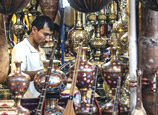
WASHINGTON, July 1 (Xinhua) -- Radioactive carbon atoms created by nuclear bomb tests in the 1950s and 1960s may be used to reveal the year an elephant died, and thus whether the ivory was taken illegally, a U.S. study said on Monday.
The method, described in the journal Proceedings of the National Academy of Sciences, is a bit like telling a tree's age by its rings, but instead of counting rings, it measured radioactive carbon-14 deposited in tusks and teeth.
The radioactive carbon-14 was formed in the atmosphere by U.S. and Soviet atmospheric nuclear weapons tests in Nevada and Siberia from 1952 through 1962. Those levels peaked in the 1960s and have declined ever since but still are absorbed by and measurable in plant and animal tissues, researchers at the University of Utah said.
The conventional way of measuring carbon-14 is to wait for and count when the isotope decays radioactively, but the study used accelerator mass spectrometry (AMS), which requires 1,000 times less material for analysis, a big advantage when sampling fossils or small pieces of worked ivory, the researchers said.
In the AMS, the material being analyzed is bombarded with cesium atoms, which sputters off carbon atoms so the ratio of carbon-14 to carbon-12 can be measured.
The researchers tested the accuracy of carbon-14 dating in 29 animal and plant tissues killed and collected on known dates from 1905 to 2008. The samples included elephant tusks and molars, hippo tusks and canine teeth, oryx horn, hair from monkeys and elephant tails, and some grasses collected in Kenya in 1962.
The analysis revealed that various tissues that formed at the same time have the same carbon-14 levels, and that grasses and the animals eating them had the same levels. By determining carbon-14 in these samples of known dates, the researchers now can measure carbon-14 levels in other ivory to determine its age, within about a year.
"It has immediate applications to fighting the illegal sale and trade of ivory that has led to the highest rate of poaching seen in decades," the study's first author, Kevin Uno, who did the research for his University of Utah Ph.D. thesis, said in a statement.
Uno added that the dating method is "affordable and accessible to government and law enforcement agencies, costing about 500 dollars per sample."
International agreements banned most trade of raw ivory from Asian elephants after 1975 and African elephants after 1989. Yet tons of illegal ivory still are sold because dealers claim the ivory was taken before the ban and there has been no test to prove them wrong, the researchers said.
"With an accurate age of the ivory, we can verify if the trade is legal or not" when the age is combined with existing DNA analysis to determine if an elephant is from Africa or Asia, Uno said. "Currently 30,000 elephants a year are slaughtered for their tusks, so there is a desperate need to enforce the international trade ban and reduce demand."
















 China's weekly story (2013 6.22-6.28)
China's weekly story (2013 6.22-6.28)


![]()
